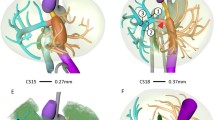Summary
Reconstruction of human embryonic livers (Streeter's developmental horizons XVI, XIX and XX) showed that hepatic segmentation arises between the 35th and 45th day of intrauterine life and that the vena umbilicalis sinistra plays an important role in this developmental phenomenon. Conversely, the results of this study demonstrated the regressive and non functional nature of the vena umbilicalis dextra and vitelline vessels. Furthermore, our observations allowed to identify the embryonic period during which umbilical blood flow begins to invest the mass of hepatic cells and runs about the sinusoids. The flow pattern described in this report induces special fluid currents which are reflected by a progressive increase in the variability of the venous structures lying more and more distally to the point of entry of the vena umbilicalis sinistra in the liver. These hemodynamic phenomena could thus account for the constancy of the left part and the variability of the right part of the liver, as well as the variability of the site of origin of the right paramedian vein with respect to the bifurcation of the vena portae.
The results of this study argue in favor of a hemodynamic theory of the organogenesis of the venous structures of the human liver. It is proposed that this new theory replace the widely held vestigial theory of hepatovascular organogenesis.
Résumé
Des reconstructions personnelles de foies embryonnaires humains (horizons XVI, XIX, et XX de Streeter) permettent de préciser la date d'apparition de la segmentation hépatique entre le 35e et le 45e jour, et montrent l'importance de la veine ombilicale gauche (v. umbilicalis sinistra) ainsi que le caractère régressif et non fonctionnel de la veine ombilicale droite (v. umbilicalis dextra) et des vaisseaux vitellins. Elles permettent également de préciser la date où le flux ombilical envahit la masse des cellules hépatiques et s'écoule entre les sinusoïdes où il provoque des courants préférentiels qui se traduisent par une angio-architecture de plus en plus variable à mesure que l'on s'éloigne du point d'entrée de la veine ombilicale gauche dans le foie: la constance du foie gauche, la variabilité du foie droit et la variation du lieu de naissance de la veine paramédiane droite par rapport à la bifurcation de la veine porte (vena portae) trouvent ainsi leur explication.
En définitive, ces travaux plaident en faveur d'une théorie hémo-dynamique de l'angio-architecture veineuse du foie humain: elle devrait remplacer la théorie des vestiges jusqu'ici retenue.
Similar content being viewed by others
References
Barry A (1963) The development of hepatic vascular structures. Ann NY Acad Sci 111:105–109
Bonne C (1904) Sur le rôle respectif des veines ombilicales et vitellines dans la circulation hépatique embryonnaire. Lyon Méd 4:134–140
Bonne C (1904) Recherche sur le développement des veines du foie chez le lapin et le mouton. J Anat Physiol 40:225–267
Catayee G (1952) A propos de l'organogénèse du foie chez l'embryon de poulet (Etude morphologique et histo-enzymatique durant les tous premiers stades du développement. Thèse Montpellier
Couinaud C (1957) Le foie. Etudes anatomiques et chirurgicales. Masson, Paris
Elias H, Sherrick JC (1969) Morphology of the liver. Academic Press, New York London
Géraudel EJ (1907) Le parenchyme hépatique et les voies biliaires sont deux formations génétiquement indépendantes. J Anat Physiol 43:410–431
Hiss W (1881) Arch Anat Entwicklungsgesch 321
Hugues L (1943) Etude de la circulation hydro-dynamique à travers les terrains sablonneux. Thèse Doctorat és Sciences, Marseille
Lassau JP (1966) L-organogénèse du foie humain. Contribution à l'étude de la formation de l'angioarchitecture hépatique. Thèse, Paris
Le Douarin N (1964) Induction de l'endoderme pré-hépatique par le mésoderme de l'aire cardiaque chez l'embryon de poulet. J Embryol Exp Morphol 12:651–664
O'Rahilly R, Bossy J, Müller F (1981) Introduction à l'étude des stades embryonnaires chez l'homme. Bull Assoc Anat 65:141–234
Streeter GL (1951) Developmental horizons in human embryos age groups XI to XXIII. Embryology (Reprint vol II) 196 p. Carnegie Institution of Washington
Tourneux F (1898) Précis d'embryologie humaine. Doin, Paris
Author information
Authors and Affiliations
Rights and permissions
About this article
Cite this article
Lassau, J.P., Bastian, D. Organogenesis of the venous structures of the human liver: A hemodynamic theory. Anat. Clin 5, 97–102 (1983). https://doi.org/10.1007/BF01798980
Issue Date:
DOI: https://doi.org/10.1007/BF01798980




